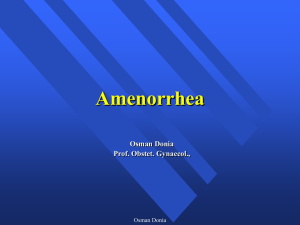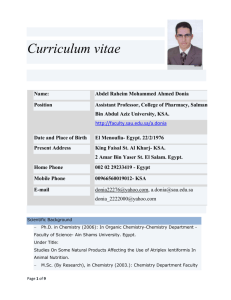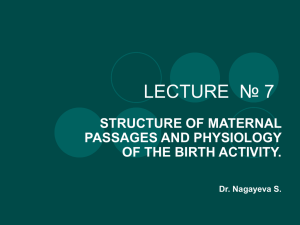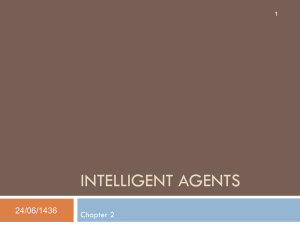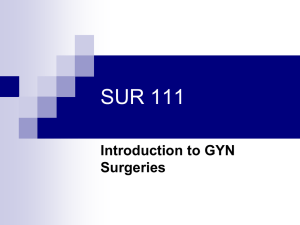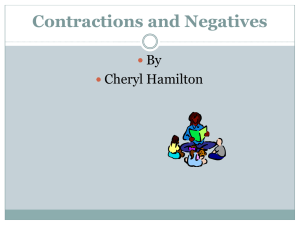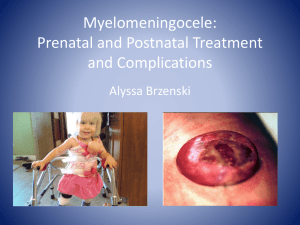Normal-Labor-DrOsman
advertisement
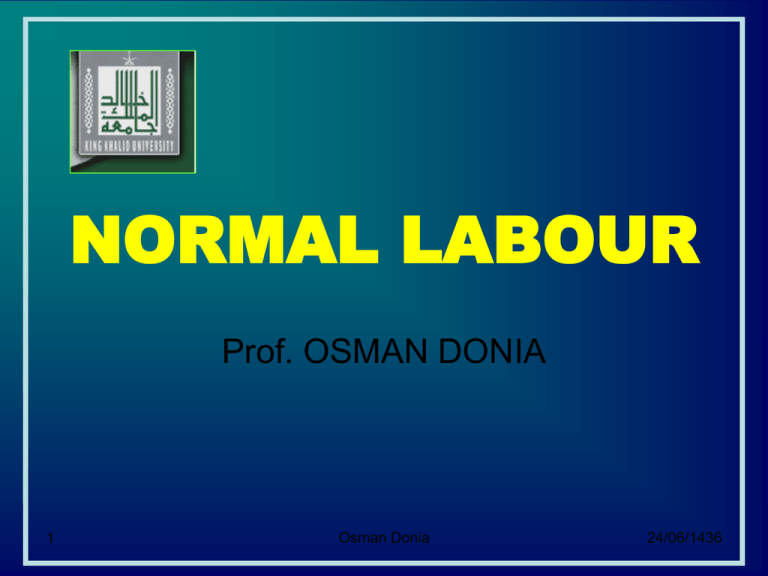
NORMAL LABOUR Prof. OSMAN DONIA 1 Osman Donia 24/06/1436 NORMAL LABOUR DEFINITIONS Labor "Tocia": Labor is the process of expulsion of the fetus from the uterus after viability. Viability: Is a reasonable chance of the fetus for extrauterine survival (28 weeks in Egypt, 22 weeks in USA) Normal labor “Eutocia”: Normal labour entails the spontaneous expulsion of a single living full term fetus, in a vertex cephalic presentation, through the natural birth canal after spontaneous onset of true labor pains, without assistance and without complications to the mother or fetus. The average duration of normal labour: 12-18 hours in the primigravida 6-10 hours in the multigravida 2 Osman Donia 24/06/1436 INCIDENCE: It should be noted that “normal labor” is a retrospective diagnosis. The majority of labours are normal however the true incidence is difficult to estimate. POSITIONS: 1. 2. 3 Left and Right occipitoanterior (LOA and ROA). Left and Right occipitotransverse (LOT and ROT). Osman Donia 24/06/1436 STAGES OF LABOUR First stage: From start of labour to full dilatation of cervix. It is divided into latent phase and active phase Second stage: From full dilatation to birth of baby Third stage: From the time of delivery of fetus to expulsion of placenta and membranes Fourth stage: Upto 6hrs after birth to rule out post partum haemorrhage • • • • DIAMETERS OF THE INLET DIAMETERS OF THE OUTLET 7 Osman Donia 24/06/1436 FOETAL SKULL FOETAL SKULL FOETAL SKULL Summary of presenting diameters with different presentations Vertex Suboccipito–bregmatic 9.5 cm Deflexed OP Occipito–frontal 11.5 cm Brow Mento–vertico 13 cm Face Submento–bregmatic 9.5 cm 12 Osman Donia 24/06/1436 MECHANISM OF DELIVERY It is the changes in the attidude and position that the foetus undergoes during its passage though the birth canal. A. DELIVERY OF THE HEAD 1- Descent: - A continuous movement throughout labor due to: - Uterine contractions & retractions. - Auxiliary force in the 2nd stage of labor. - Straightening of the fetus caused by contraction & retraction of the uterus. 2- Engagement: 13 Is the passage of the widest transverse diameter of the presenting part through the plane of the pelvic inlet. In cephalic presentation it is the passage of the biparietal diameter through the plane of the pelvic brim. Osman Donia 24/06/1436 3- Increased flexion: When the head meets resistance during its descent, the force applied on the sinciput is greater than that on the occiput leading to increased flexion. It is explained by the two armed lever theory, where the head is represented by two armes of unequal lengths: - A short arm : extends from the occiput to the atlanto-occipital joint . - A long arm : extends from the sinciput to the atlanto-occipital joint. Results of increased flexion: - The head enters the pelvis with the smallest suboccipito-bregmatic diameter (9.5 cm.) - The occiput meets the pelvic floor first preparatory to internal rotation. - The part of the head occupying the plane of the greatest dimensions is like a circle, as the biparietal & suboccipito-bregmatic diameters are both equal (9.5 cm). This will facilitate internal rotation of the head . 14 Osman Donia 24/06/1436 4- Internal rotation: This means anterior rotation of the occiput 1/8th of a circle (45°) as it meets the pelvic floor first. It occurs at the level of the plane of the greatest pelvic dimensions Internal rotation is explained by: -Direction of the forward sloping gutter of the levator ani muscles. The direction of the gutter is downwards forwards and medially. -Rifling action of the pelvis : The largest available diameter at the inlet is the oblique, while at the outlet is the antero-posterior diameter. 90%of cases of occipitoposterior rotate 3/8th of a circle to become occipito-anterior. These cases will be delivered as in occipito-anterior. 15 Osman Donia 24/06/1436 5- Extension: The suboccipital region hinges under the symphysis pubis. The head is acted upon by 2 forces at this level in the pelvis :Downward & forward force of the uterine contractions ,Upward & forward force of the pelvic floor. The net result is passage of the head forward i.e. extension. 6- Restitution: The occiput rotates 1/8th of a circle in an opposite direction to internal rotation, to undo the twist of the neck caused by internal rotation . 7- External rotation: Rotation of the occiput 1/8th of a circle in same direction as restitution. It is due to internal rotation of the anterior shoulder, 1/8th of a circle from the oblique to the anteroposterior to the posterior diameter 16 Osman Donia 24/06/1436 B. DELIVERY OF THE SHOULDERS AND BODY - The anterior shoulder hinges below the symphysis. - The posterior shoulder is delivered first by lateral flexion of the spine. - The anterior shoulder then follows, then the rest of the body. 17 Osman Donia 24/06/1436 18 Osman Donia 24/06/1436 Cardinal Movements of Normal Delivery 19 Osman Donia 24/06/1436 20 Osman Donia 24/06/1436 FRIEDMANNS CURVE Progress in labour CERVICAL CHANGES CERVICAL CHANGES Engagement and descent Fetal head descends through the birth canal Defined relative to the ischial spinIsssssches 0 station = top of head at the spines (fully engaged) +2 station = 2 cm past (below) the ischial spines • • • • 28 Osman Donia 24/06/1436 Abdominal examination Vertex, breech or transverse lie • Palpate vaginally • Leopold’s Maneuvers • Monitoring of fetal heart MANAGEMENT OF LABOUR Initial Assessment History Onset of labour pains and their quality. Presence of show & escape of liquor. In case of ROM: its colour and amount. Presence and pattern of foetal movement. General Examination Pulse, Blood pressure, and Temperature Degree of anxiety. Degree of dehydration Observation of height and weight. 31 Osman Donia 24/06/1436 Abdominal examination Frequency, duration and intensity of uterine contraction To determine the lie, presentation and position. Engagement of the presenting part F.H.S. (site, rate, rhythm) The foetal heart sounds should be checked especially at the end of a contraction and immediately thereafter, to identify pathological slowing of the heart rate. 32 Osman Donia 24/06/1436 Vaginal examination: - To exclude contracted pelvis. - To assess dilatation and effacement of the cervix. - To determine foetal presenting part (presentation, Position, and degree of flexion). - To detect condition of membranes and if ruptures the presence or absence of meconium. - Presence of prolapse of the cord. Station of the presenting part: When the lowest part of the fetal head is felt at the level of the ischial spines, this is called zero station. Station + 1, +2 & +3, means that the lowest part of the head is 1,2 or 3 cm lower than the ischial spines. Station -1, -2 & -3, means the lowest part of the head is 1,2 or 3 cm higher than the ischial spines. 33 Osman Donia 24/06/1436 Frequency of vaginal examination: This depends on the obstetrician, but at least it is done twice; - At the start of labor. - If rupture of membranes occurs to exclude cord prolapse. Electronic FHR monitoring: (CST): Done during and inbetween uterine contractions whenever indicated. 34 Osman Donia 24/06/1436 MANAGEMENT OF THE 1ST STAGE OF LABOR 1.Preparation Antisepsis :The vulva is shaved & cleaned with an antiseptic. Evacuation of the bladder & rectum: This is done to prevent reflex uterine inertia. The bladder is evacuated by frequent micturition or by a catheter. The rectum is evacuated by an enema, which also prevents contamination . 35 Osman Donia 24/06/1436 2. Observation: For the mother, fetus, and progress of labour a. The mother :for - Pulse, blood pressure, temperature and respiratory rate. - Uterine contractions: § Contractions are observed for frequency, strength and duration; § By the palm of the hand applied on the abdomen. § By a toco-dynamometer i.e. a device applied on the abdomen. - Cervical dilatation. - Descent of the fetus i.e. pelvic station. - Rupture of membranes. b. Fetal heart sounds (FHS): - Normally the FHS are regular with a rate of 120-160 beats / minute. - The aim of auscultating the FHS is to detect fetal distress e.g. bradycardia . - Methods of detection of the FHS: § Intermittent by the sonicaid or Pinard stethoscope every 30 minutes. § Continuous electronic monitoring is indicated in high-risk cases. 36 Osman Donia 24/06/1436 3. Nutrition: - Early in labor i.e. in the latent phase, oral sugary fluids are given. - In the active phase, oral feeding is avoided, as delayed gastric emptying may lead to vomiting & aspiration if general anesthesia is needed at any time "Mendelson syndrome" - If labor is prolonged more than 8 hours, IV fluids as glucose 5% and saline are given. 4. Pain relief: - Pethidine 50 mg IM is commonly used. Pethidine causes fetal respiratory depression & should be stopped 2 hours before the 2nd stage of labor, to avoid fetal respiratory depression at birth . - Epidural analgesia is an alternative. 37 Osman Donia 24/06/1436 38 Osman Donia 24/06/1436 5. Instructions: - If the membranes are ruptured: Rest in bed in the lateral position. - If the membranes are intact: - Walking is allowed in between uterine contractions. -Straining (bearing down) should be avoided because: § It is useless & exhausts the patient. § It predisposes to genital prolapse. 39 Osman Donia 24/06/1436 ”Partogram“ This is a graphic record of labour which allows an instant visual assessment of the rate of cervical dilatation against an expected norm according to parity of the women so that active management can be instituted immediately. Other observations can be recorded on the chart as the frequency and strength of contractions the descent of the head, timing of rupture membranes, medications given and the basic observations as the blood pressure, pulse rate and temperature. Figure for partogram 40 Osman Donia 24/06/1436 MANAGEMENT OF THE 2ND STAGE OF LABOR Identification of the 2nd stage: 1- Full dilatation of the cervix (10 cm or 5 fingers): The most sure sign. 2- Desire of the patient to evacuate the rectum. 3- Reflex desire to bear down. 4- Bearing down is accompanied by an expiratory grunt. 5- Rupture of membranes: - In 1st stage ,the amniotic sac is divided by contact of the head and cervix into (A): The bag of hind-waters( B :)The bag of fore-waters i.e. the head forms a ball valve mechanism between both bags . - After full cervical dilatation ,The hind & fore-waters become continuous leading to increased pressure in the fore-waters & rupture of membranes. - It should be noted that rupture of membranes may occur early before the 2nd stage of labor. 50 Osman Donia 24/06/1436 CONDUCT OF LABOR: 1- Preparation : - Delivery is carried out in the delivery room or operation theater. - The patient is put in the Lithotomy or dorsal position. - The vulva & perineum are washed by an antiseptic from before backward. - Sterile towels are applied on the patient. 2- Instructions :The patient is instructed to strain during contractions & to relax in between. 3- Delivery of the head and prevention of perineal tears: Crowning: - It is passage of the biparietal diameter through the vulval ring. - It is identified when the head does not recede in between contractions. - After crowning, extension of the head will distend the vulva by the suboccipito-frontal diameter (10 cm.) - Before crowning, extension of the head will over-distend the vulva by 51 Osman Donia 24/06/1436 the occipito-frontal diameter (11.5 cm) with liability to perineal tears. a. Perineal support: - It is done by a sterile dressing when the head appears at the vulva. - It is done to prevent extension of the head before crowning. b. Delivery of the head should be: - Slow, in between uterine contractions & without bearing down. -Aided by Ritgen maneuver, which is controlled extension of the head c. Episiotomy : - Episiotomy is a perineal incision during labor to prevent perineal tears. -Timing: It is done when the head maximally distends the vulva . (See Episiotomy in Obstetric Operations) 52 Osman Donia 24/06/1436 Restrictive use of episiotomy 4- After delivery of the head: • • • • • • • • • • • Clearance of the air passages by swabbing & aspiration. Coils of the umbilical cord around the fetal neck: One loop is slipped. Several loops are doubly clamped & the cord is cut in between. Delivery of the shoulders & body: Gentle downward traction on the head is done till the anterior shoulder appears under the symphysis pubis. The head is then lifted upward to deliver the posterior shoulder first. The head is then depressed downwards to deliver the anterior shoulder. Handling of the fetus: After delivery, the fetus is held from its ankles. Lifting the fetus from the ankles is avoided if: a. Asphyxia or suspicion of intracranial hemorrhage. b. Preterm fetuses. • The umbilical cord is cut between 2 clamps • Milking the cord, should not be done in • Rh incompatibility, to avoid bringing more antibodies Osman Donia •54 Preterm fetuses, to avoid circulatory overload 24/06/1436 MANAGEMENT OF THE 3RD STAGE OF LABOR Duration: 5-10 minutes, if more than 30 minutes it is considered a prolonged 3rd stage. A. Conservative method : 1- Exclusion of bleeding & uterine atony: -The ulnar border of the left hand is put on the fundus -A rise of the fundal level of a lax uterus points to bleeding inside the uterus, but avoiding massage or kneading. 2- Signs of separation of the placenta are awaited: -The body of the uterus becomes smaller, harder & globular. -Suprapubic bulge due to presence of the placenta in the lower uterine segment -Elongation of the cord without receding. -Gush of blood from the vagina due to expulsion of the retroplacental clot. 55 Osman Donia 24/06/1436 3 .Uterine massage: Allows contraction of the uterus and controls bleeding. 4 .Placental expulsion: This is done by asking the patient to bear down or by fundal pressure. Fundal pressure is avoided if the uterus is lax, to avoid inversion of the uterus . 5 .Uterine stimulants: - To prevent atonic postpartum hemorrhage; - Ergometrine 0.25 mg IM or oxytocin 5 units IV drip are given. Disadvantages: - Takes longer time - Risk of postpartum hemorrhage is 5% 56 Osman Donia 24/06/1436 B. Active method "Modern management :" 1. Uterine stimulants: With delivery of the anterior shoulder, ergometrine 0.25 - 0.5 mg IV is given, to produce strong uterine contractions & thus rapid placental separation . 2. Brandt-Andrews method "Conttrolled cord traction:" The left hand is put suprapubic & when the uterus contracts, the uterus is pushed upwards. The other hand exerts gentle traction on the cord. Disadvantages of the active method: Rupture of the cord. Acute inversion of the uterus if done on a lax uterus. Thus, cord traction is avoided if the uterus is lax, to avoid inversion of the uterus. Advantages of the active method : Less duration & less blood loss . Significant reduction in postpartum hemorrhage 57 Osman Donia 24/06/1436 Controlled cord traction -C. After placental delivery: - The placenta is rolled by both hands, to make the membranes like a rope, to avoid missing part of the membranes. - The placenta is inspected to avoid missing parts. - Repair of perineal tears, if more than 1 cm or if bleeding. - The vulva is washed with an antiseptic and covered by a sterile dressing. Blood loss in the 3rd stage of labor: - 200-300 ml from the placental site. - 100-200 ml from the episiotomy or perineal lacerations. - During cesarean section, blood loss from the placental site is up to 900 ml. 59 Osman Donia 24/06/1436 MANAGEMENT OF THE 4TH STAGE OF LABOR -It is the 1st hour after delivery in which postpartum hemorrhage is liable. -Careful observation to detect postpartum hemorrhage. -Uterine massage is done every 15 minutes. MANAGEMENT OF THE NEWBORN 1. Warmth: On a special heated unit with a thermal regulation. 2. Care of respiration: -The newborn is placed supine with head lowered & turned to one side. -Suction, of the mouth & nose by a catheter connected to a suction pump. -If respiration is delayed, respiration is stimulated by slapping the sole or back. -Apgar score is done for evaluation of the newborn. 3. Care of the umbilical cord stump: -Asepsis: To avoid neonatal tetanus or infections -It is ligated by 2 silk ligatures or plastic clamps 4 and 5 cm from the umbilicus. -The cord is cut distal to the 2nd ligature to avoid tying an umbilical hernia. 4. Care of the eyes: Penicillin or tetracycline drops are used to prevent infection of the eyes. 5. The weight is recorded. 6. Identification ,by an identification band or footprint of the newborn. 60 Osman Donia 24/06/1436 61 Osman Donia 24/06/1436 7. Detection of congenital anomalies e.g. Hypospadius or imperforate anus i.e. failure to pass meconium in the 1st day. 8. Vitamin K administration: To prevent hemorrhagic disease of the newborn. 9 .Physiological jaundice ,may develop after 24 hours. Effects of labor on the fetus: 1. Moulding : - Moulding is overlap of the bones of the skull vault, due to compression. - Slight moulding, helps easy passage of the head through the pelvis. - Marked moulding may cause intracanial hemorrhage. 2.62 Caput SuccedaneumOsman :seeDonia fetal birth injuries 24/06/1436 . 63 Osman Donia 24/06/1436
